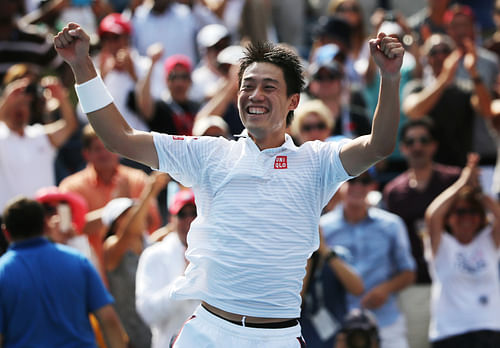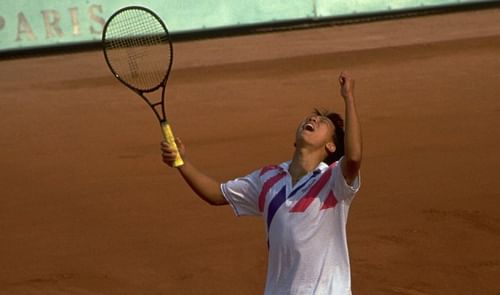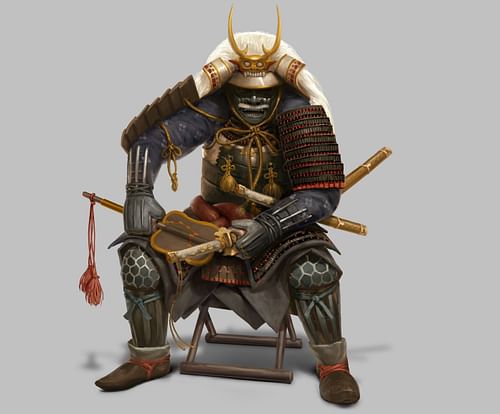
Kei Nishikori – The rise of modern Japan's first Shogun

A jubilant Kei Nishikori after beating world no.1 Novak Djokovic at the 2014 US Open
French nirvana
Under the remorseless glare of the Parisian sun, a 17-year old kid from Hoboken, New Jersey was experiencing hell - he had felt pain before, but nothing quite like this. Cramps were eating at his legs - legs that had been full of fast and non-stop running - legs that were his biggest strength, had now become his deadliest weakness. And to make matters worse, across the net strode the world’s best tennis player.
That day though, Michael Chang dived deep down into some hidden inner reservoir of immense strength to win a titanic physical battle against his own body and, arguably, a tougher psychological battle against the famously unflappable champion - Ivan Lendl. The Czech lost his cool that day, big time, as Chang frustrated his much more illustrious opponent with incredibly smart tactics - the infamous ‘moon balls’ that slowed the game down to a pace that more suited him and the underhand serve that won him a crucial point in the fifth set stood out for their sheer temerity! In the end, he would somehow go on to record a marathon 4-6, 4-6, 6-3, 6-3, 6-3 victory in a little over four and a half grueling hours.
Chang would then recover from that near-fatal bout of cramps and proceed to fly across the Roland Garros baseline over the course of the next week as he ended up lifting the coveted Coupe des Mousquetaires – not only was he the youngest male player ever to win a grand slam, he was also the first man of Asian descent to claim tennis’ ultimate prize.

An exhausted but jubilant Michael Chang after his epic match against Ivan Lendl in the 1989 French Open
Fast forward 25 years and a few odd months - September 2014 - and he was now looking down from the sidelines, as the talented young Japanese kid (who hadn’t even been born when Chang created history in Paris) he had taken to coaching at the beginning of the year produced some of the most dramatic tennis seen at Flushing Meadows as he fought toe-to-toe with the world’s undisputed no.1 - the uber-talented and uber-cool Novak Djokovic - as he vied to be the first Asian man to enter a Grand Slam final.
For, as much romantics tried to play up the “Asian-origin” bit of Michael Chang’s story, the fact remained that he was a true-blue American, having been born on American soil and having lived out his entire life in the United States. The truth still stung - no Asian had put racquet to ball in a final in 137 long years of (mens’) Grand Slam tennis. Chang’s protégé would soon set about correcting that in the most thrilling way imaginable.
That historic day Kei Nishikora went about dismantling the world’s best player in four sets of the highest quality tennis. The story of how Nishikora rose from the tiny, castle town of Matsue to fight so bravely with (and conquer) the best in the world is as worthy a tale as any the old Japanese storytellers used to weave about the great exploits of their famed samurai warriors.
The Rise of the Matsue Shogun
The Samurai were a noble warrior class that had lorded over the Land of the Rising Sun for nearly one and a half millennia. Total rule began in C.E. 709, when Kose no Moro had risen to become the all-powerful warrior in the nation, proclaiming himself Shogun (military commander) and getting all the major feudal warlords or ‘daimyos’ to pledge allegiance to him and his bloodline. The Shoguns were not just fine commanders and political masterminds – they were usually the greatest and most skilled warriors in the land, wielding their famed ‘katanas’ (swords) with alarming ferocity and consummate skill. Tokugawa Yoshinobu was the last of Japan’s Shoguns, the age old feudal system officially finally yielding to westernized modernity (and massive public unrest) in 1867.
These days, the Shoguns are all dead, or so they would have you believe. In a world no longer dominated by sword and spear, Kei Nishikori employs his racquet with a dexterity that harks back to the skill with which the great Shoguns brandished their deadly katanas.

An artist’s impression of a medieval Shogun from Sega’s production – Total War: Shogun 2
With the resolute determination characteristic of the people from the great nation, and possessed of feet that appear to have wings attached to them (à la Hermes), the young man from Matsue has taken the tennis world by storm in 2014. It hasn’t always been so rosy for the young Japanese hero though.
Nishikori won his first ATP title in 2008, triumphing at the Delray Beach International after upsetting top seed James Blake. He couldn’t keep up the momentum though and was frustrated by an injured right elbow for most of the next year. He would then embark on that well-trodden path of the journeyman tennis player – showing occassional flashes of great promise only to be plagued by injuries off the court and maverick displays on it.
By the end of 2013, however, he showed signs of sustaining good form for longer periods and climbed to 16 in the world rankings after winning a couple of ATP titles. It was the 2014 season however, that would turn his life around. Employing Michael Chang as coach, Nishikori paid heed to the likeminded baseline-battling champion’s tutelage and broke into the top 10 rankings for the first time in his career.
In May, he would reach his first Master 1000 tournament final, marching into the Madrid Open final to face off against the King of Clay, Rafael Nadal. He won the first set with an incredible display of speed and fortitude and was playing extremely well, albeit he had lost the second set narrowly, when a back injury forced him to withdraw in the third. When you hear Toni Nadal say, “We don’t deserve the victory, (Nishikori) deserves it, he played better than us the whole time”, you get a glimpse of just how well he had played.
That might well have been his greatest moment of the year – giving the great Nadal a huge scare on a surface he has ruled over with an iron fist for the best part of a decade is not something just anybody can do – but destiny had other, bigger, plans in store for the budding Japanese Shogun.
The American dream - with a Japanese touch
When the rambunctious, jazzy mega show of a Grand Slam that is the US Open rolled around in all its might and fancy, Nishikori had just been recovering after removing a cyst on his right foot – an operation that had left him unable to practice as much as he would have liked. Chang convinced him to give it a shot anyway, telling him that if he could get past the first couple of rounds, anything could happen.
How prophetic those words of encouragement would turn out to be – he beat Wayne Odensik, Pablo Andujar and Leanardo Mayer in the first three rounds with the minimum amount of fuss to set up a fourth round tie with fifth seed Milos Raonic. In an epic clash, Nishikori triumphed, his greater accuracy and mammoth endurance paying off as he saw off the dangerous Canadian 4-6, 7-6, 6-7, 7-6, 6-4 in a match that ended at 2.26 am local time– third US Open match to end at that record time!
This set up a quarterfinal date the very next day with Australian Open champion and 3rd seed Stanislas Wawrinka. In another five set classic, the Japanese warrior outlasted his fabulously skilled Swiss opponent 3-6, 7-5, 7-6, 6-7, 6-4 in yet another colossally long match. His reward for nearly nine grueling hours of tennis in two days? - A semifinal match-up against the world no.1! He would put up a display of his finest qualities on Centre Court, his seemingly endless endurance, and excellent use of the angles from the baseline powering him to victory over the great Serb.
The final would prove to be an anti-climax for his growing fanbase, as the Japanese hero got a whipping from the big serving Marin Cilic. The giant Croat (playing the tennis of his life after a heroic and inspiring transformation mid-career) created some history of his own by winning his first Grand Slam title (his nation’s second men’s Grand Slam winner – his coach and idol, the cult hero Goran Ivanesevic was the first) with the fairly straightforward 6-3, 6-3, 6-3 victory over the noticeably (and understandably) fatigued Nishikori. (Take nothing away from Cilic though – very few players, even on their A-game, could have stopped the champion Croat this New York autumn)
In Japan however, glorious failures are celebrated as much as any triumph, and Kei Nishikori will return to a hero’s welcome.
If there is any one quality that personifies the Japanese, it’s their awe-inspiring capacity to bounce back from calamity and loss - and one hopes the young Shogun from Matsue displays those tremendous qualities to the fore in the years to come. With Wawrinka and Cilic winning their maiden Grand Slams, and Nishikori’s inspiring run at Flushing Meadows, it appears there are credible challengers now to the old order that had had a stranglehold over the men’s game for so very long. It’s going to be exciting; 2015 may just be the year of the Shogun.
For now, Sayonara and many thanks Nishikori-san. Come the new year, Australia – and destiny – beckons.